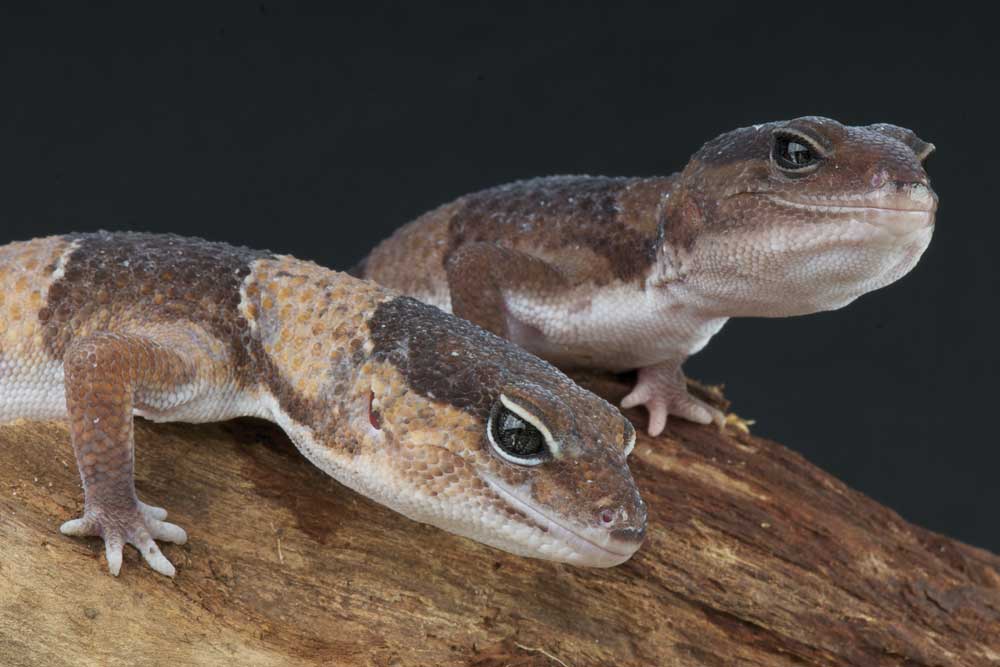The African fat-tailed gecko (Hemitheconyx caudicinctus) is an inconspicuous species of lizard that is small in size, friendly, and hardy when cared f
The African fat-tailed gecko (Hemitheconyx caudicinctus) is an inconspicuous species of lizard that is small in size, friendly, and hardy when cared for properly. Their vibrant colors, unique behaviors, and calm dispositions have made them popular with reptilekeepers. They are sometimes referred to simply as “AFTs.” They are often confused for the leopard gecko, Eublepharis macularius, because of their similar appearance. A closer look though will reveal their special and separating traits. African fat-tailed geckos are not as popular as leopard geckos, but they are comparable in many ways. Their similarities may be significant, but it is still important to understand that they have species-specific differences in lifestyle and captive care and they should not be considered the same.
Eublepharidae Family
As AFTs popularity increases, the knowledge on their captive requirements has too! Like all reptiles, adequate research is suggested to provide them with a high-quality life in captivity.
The African fat-tailed gecko, Hemitheconyx caudicinctus, gets its name for their large and round, fatty tails. To the untrained eye, they may look nearly identical to their cousins, the leopard gecko, Eublepharis macularius. The two belong to the same family, Eublepharidae, which includes more than 40 species of geckos that belong to the “true geckos” group, Gekkonidae. This group of geckos are very diverse and can be found within North America, Asia, and Africa.
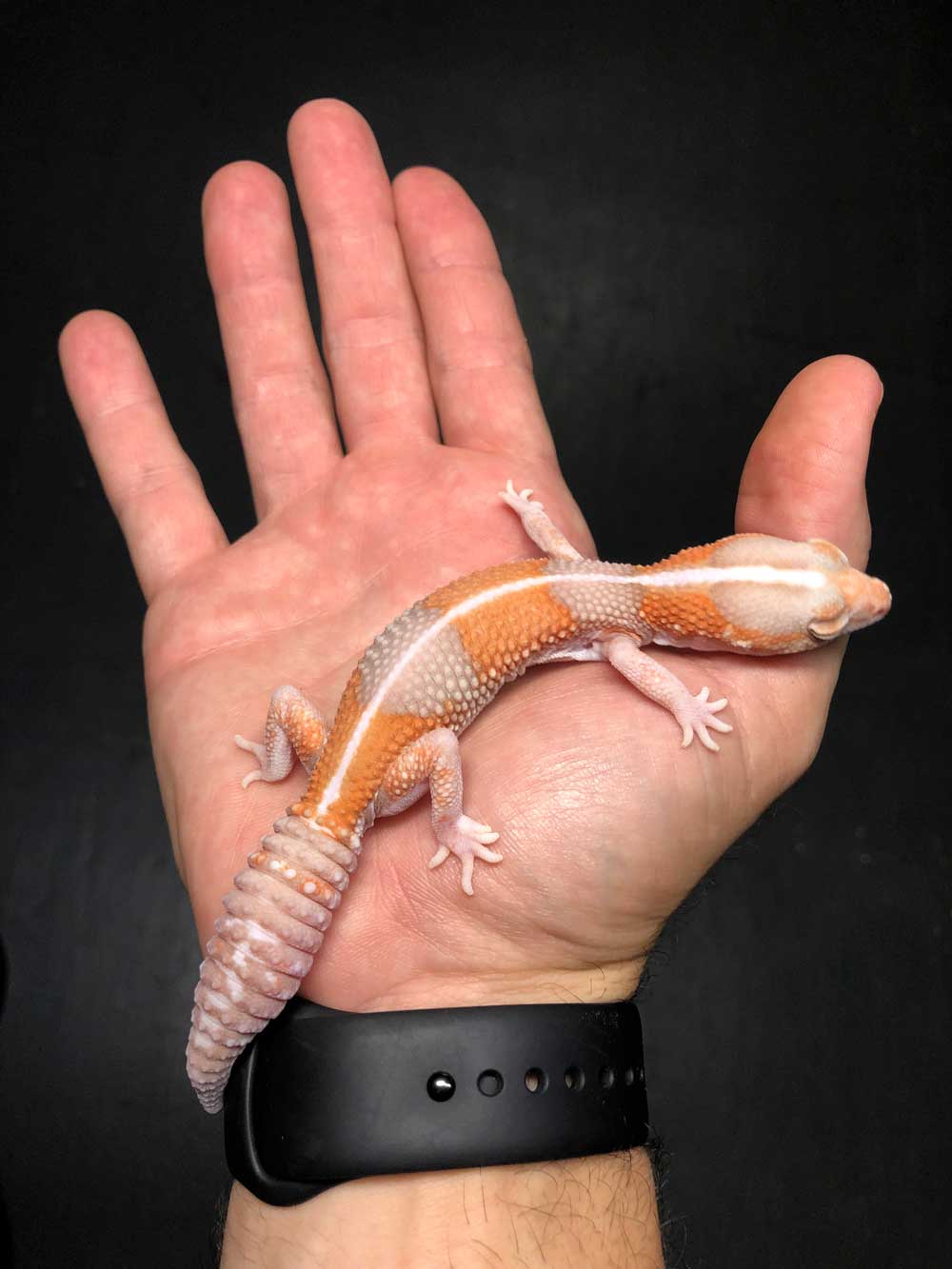
African fat-tailed geckos are tolerant of handling. Be careful with the juveniles though as they can be skittish.
Photo by Rebekah Pettit.
Many species belong to this family because of their shared characteristics. For example, Eublepharidae lack toe pads, called setae, which allow certain species of gecko to stick to surfaces. Setae are associated with species like the crested gecko (Correlophus ciliatus) and tokay gecko (Gekko gecko), who have large, sticky feet. Another defining characteristic of the Eublepharidae family are their eyelids, which have the ability to move. For most other gecko species, this is not possible.
Although diverse and varying by distances, 40 gecko species fit into the Eublepharidae family, such as the cat geckos (Aeluroscalabotes felinus), the banded geckos (Coleonyx spp.), and the cave geckos (Goniurosaurus spp.), to name a few. Some of these species do very well in captivity, and others do not. Each gecko species is individual in all ways, which affects their captive care. This can include habitat, characteristics, lifestyles and more.
Description
African fat-tailed geckos are a terrestrial, nocturnal, ground dwelling species that are native to the savanna habitats in Central/Western Africa. In their wild ranges, their populations span through countries such as Nigeria, Cameroon, Senegal and others. The savanna is a vast biome that is filled with woodlands, dunes, grasslands, deserts, and more. It is incredibly variable depending on the locality. African fat-tailed geckos have been documented to live suitably in both dry and moist environments, in varying elevations from 0 to 1500 meters. In the wild, temperatures are usually always warm or hot (an average of 78 degrees Fahrenheit or 25.6 degrees Celsius) and humidity levels are typically high. The savanna relies on seasonal rainfall. Due to their savanna habitat, African fat-tailed geckos have unique characteristics.
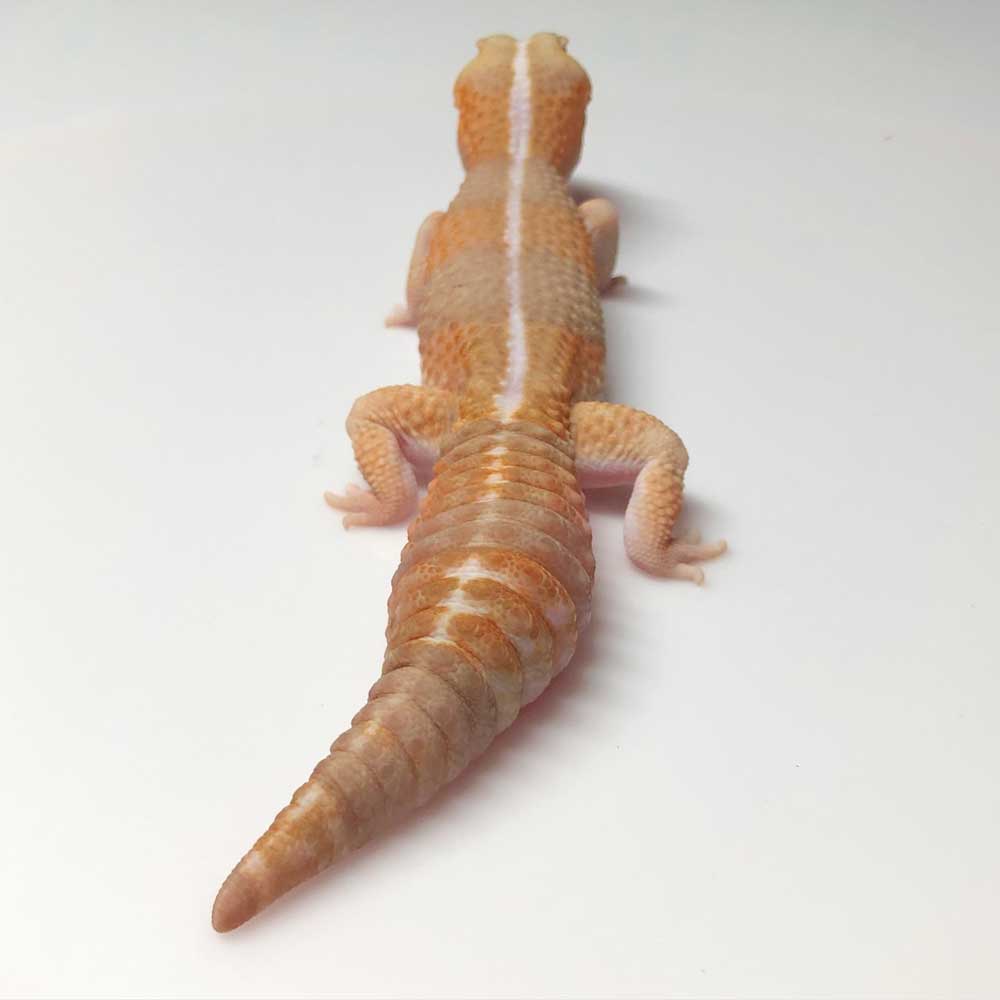
African fat-tailed geckos are smaller but can be thicker than leopard geckos. Photo by Rebekah Pettit
Storing Body Fat
African fat-tailed geckos get their common name from their fat tails, which are unsurprisingly filled with fat cells. It gives this ground dwelling gecko a thick and large look on their back sides, which can vary in shape. A thick and stout tail is a defining characteristic of a healthy African fat tail. Fat is a type of macromolecule called a lipid. In vertebrates, including reptiles, it is often stored in the form of adipose tissue, which is commonly called body fat. Body fat stores lots of energy, which in times of starvation, can be used as a survival mechanism. This notable characteristic of the African fat-tailed gecko is important, since it allows them to survive an extended period of time without food. Their tails can be nearly half of their body size, which proves to be beneficial in extreme circumstances. They also have the ability to lose their tails, which can then regenerate.
Life can be brutal in the savanna, and survivability and resilience are a necessity of most wild animals that live here. The tails of the African fat-tailed geckos can be used for multiple reasons besides energy reserves. One interesting characteristic of the fat tail is the “teardrop” shape variation, which may be used as a mimic for their heads. This could be used as a defense mechanism to deter predators and confuse them. In the wild, African fat-tailed geckos face a multitude of predators that share their ecosystem like birds, mammals, and larger lizards. Other tail behaviors have been documented in the species, such as shaking or vibrating during feeding or hunting. More research is needed to fully understand the use and behaviors of the notable fat tail of this species.
Color
The typical coloration for African fat-tailed geckos is a brown color, with contrasting stripes and variable patterns of brown, orange, or white on the back. Many wild-type specimens have a white stripe going along their backs that is distinct. This wild-type coloration allows them to properly blend into their surroundings, and gives them a distinguished look in comparison to other gecko species. There are many wild-type variations of this species.
Size
African fat-tailed geckos are smaller than leopard geckos, but they can be thicker. African fat-tailed geckos can range in size from 4 to 8 inches as adults and weigh an average of around 40 to 80 grams. Although smaller than some other lizards, African fat-tailed geckos are solid and stocky when healthy. Males are typically larger than females, displaying dimorphism. Like all reptiles, African fat-tailed geckos are ectothermic, and they rely on their environment for their body temperatures. They are generally considered a desert species. Current information seems to be limited on the details of lifestyle, physiology, and population trends of the species. More research is needed to better understand this species in the wild. Until then, captive management has provided most information on the species.
Behavior
African fat-tailed geckos are typically solitary, though they will engage in certain behaviors such as vocalization, territorialism and mating. Males will physically fight for territory, which can be violent. Male African fat-tailed geckos will use vocalizations to communicate or mate. Vocalizations may be squeaky or click sounding, but may be unique per individual. More research is needed to better understand their behaviors.
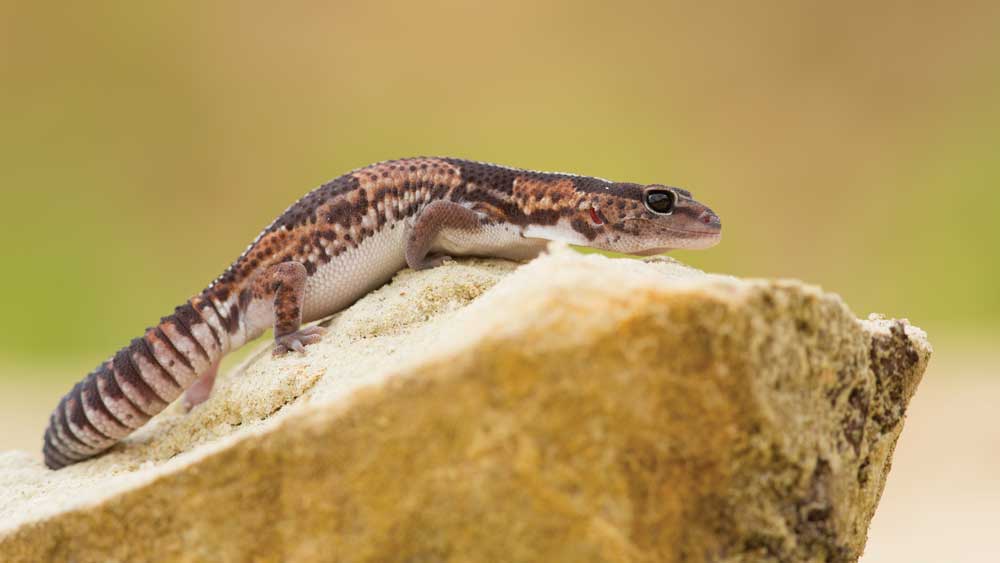
The tail of the African fat-tailed gecko stores fat. Photo by Milan Zygmunt/Shutterstock
As noted before, moveable eyelids of the Eublepharidae geckos are unique, and come in handy in the wild for African fat tails. Their eyelids provide protection for their big, round eyes as they live as ground dwellers in dusty substrate. During the day, African fat-tailed geckos are known to shelter beneath rocks and other natural hides such as burrows and termite mounds. They seem to be well suited for ground life and living within the diverse microtopography of the savanna, where they spend most of their life in the wild. It does not appear that African fat-tailed geckos are kept as pets in their native regions, but they are still collected from the wild in some cases.
Diet
African fat-tailed geckos are a type of carnivore called insectivores, which feed on a variety of insects. In the wild this can include worms, crickets, and other invertebrates. Since they are nocturnal, they hunt during the night with their large and round eyes that help them identify their prey.
Exotic Insect Feeders For Your Herps
Which Gecko Species Is Right For You?
African fat- tailed geckos have wide heads, which can allow them to eat large invertebrates like roaches and beetles. Their solid jaws, which give them a permanent looking smile, are filled with ridged teeth that allow them to easily grab hold of insects. They will lose teeth continuously throughout their lives, which are then replaced. Like other gecko species, the African fat-tailed gecko will also eat its shed skin, though the reasoning for this is not well understood. It is probably for extra nutrition.
Wild Populations
The population is listed as “least concern” by the IUCN, but research is lacking in nearly every aspect regarding the species. More research is needed to better understand the lifestyle, habitat, and conservation status of the species. Population trends are currently unknown, but are speculated to be stable in their native ranges. Wild African fat-tailed geckos face habitat loss through agriculture, but they naturally occur in protected areas, which is beneficial. Wild collection for the pet trade is a small threat to local areas. They are widely captive bred in the hobby, so there is no need to purchase wild caught specimens as pets. They do not seem to be facing any significant threats documented right now, but research is limited.
Captivity
The rising success of African fat-tailed geckos in captivity has provided many benefits, like better understanding many of their needs and behaviors. Captive breeding always relieves the pressure of wild collection, which benefits their conservation. African fat-tailed geckos have also been used for various academic research studies on multiple topics. Their success in captivity reduces the need for wild caught specimens and provides insight to their biology and captive requirements. A captive breeder will usually provide the highest quality animals. A captive bred animal is always the better option compared to wild caught specimens, which limits the risk of disease and stress in captivity.
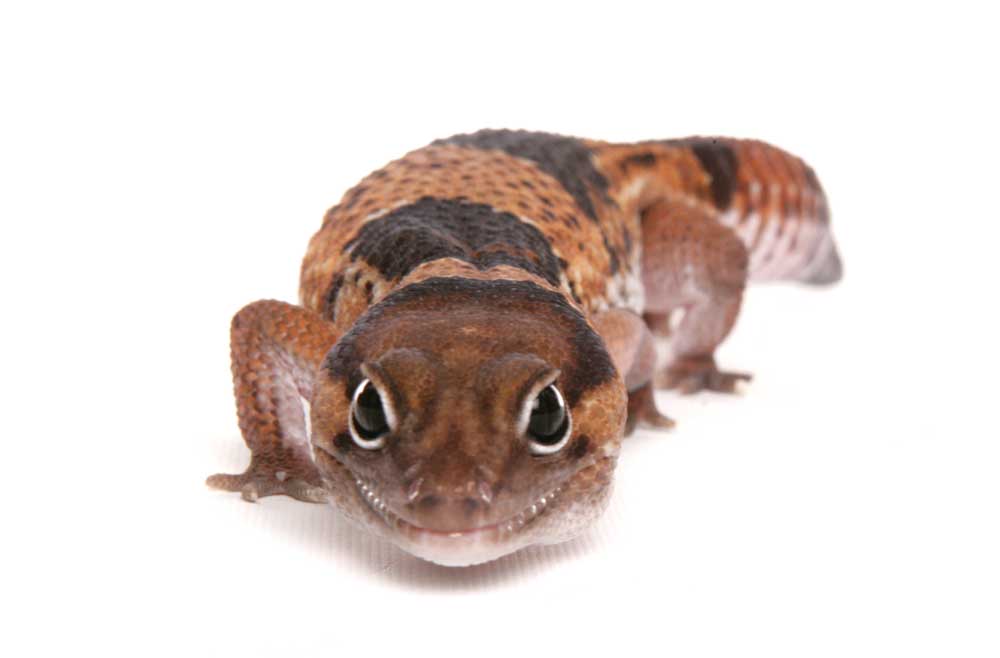
African fat-tailed geckos are a terrestrial, nocturnal, ground dwelling species that are native to the savanna habitats in Central/Western Africa. Photo by chrisbrignell/Shutterstock
African fat-tailed geckos are becoming more available in captivity as their popularity has rapidly increased since the 1990s, though they are still nowhere near as popular as leopard geckos. Despite this, African fat-tailed geckos are important to the pet trade and have proven to be valuable in this industry overall. Their beautiful colors, docile nature, and successful breeding makes them a great pet when properly cared for. Overall, their captive success benefits their conservation as more are produced.
Captive Breeding and Morphs
There are now a variety of captive breeders available in the USA, which can be found online, at reptile shows, and your local reptile store. Multiple color morphs are now available, including the amelanistic, oreo, white out, patternless, zero, ghost, stinger, tangerine, zulu and more. These morphs are developed through selective breeding. The “amelanistic” morph is basically the albino form, with very orange patterns and a white stripe often going down its back. The “oreo” morphs have a white body with variable black splotches that contrast greatly against pale skin. The “white out” morph can have brown/orange specks and spots against pale colors with many pattern variations. The “patternless” morph variations seem to be brown, with no pattern. The “zero” morph has dark brown patterns with a distinct white stripe. The “ghost” morph has a gray, pale patterning, often with orange accents. The “stinger” morph variation has a pointed black pattern that is said to resemble the stinger of a wasp or bee. Zulu morphs are compared to the pattern of an arrow, and are contrasting in color. All of these morphs can be mixed and the genetic combinations become more complex through selective breeding. This is considered designer breeding.
Captive care of the African fat-tailed gecko is debated, and each keeper will have their own variation of “perfect” conditions. Like most other popular reptiles that are kept, they can thrive with dedicated keepers who may have different opinions and styles as to what is best. Here are the generally accepted guidelines to keeping AFTs in captivity:
African Fat-Tailed Gecko Enclosure
These geckos should not be cohabitated with any other species of gecko. African fat-tailed geckos can thrive alone, but can be kept together under certain parameters. It is a best practice that males are not kept together. Small breeding groups may be possible under monitored conditions. Males will become violent for territory and mating rights as mentioned before, which can result in injury and death. If cohabiting multiple African fat-tailed geckos together, consistent observance is extremely important to monitor the dynamics of the group. A 40-gallon equivalent terrarium is a good minimum size, and the bigger the better if a naturalistic set up is provided. There are other options that could be custom made personally or commercially. It is common for ground dwelling reptiles to become overwhelmed or stressed in very large habitats if it is barren and unnatural to them. Each animal and keeper will be a unique experience and trial and error may be required to achieve proper conditions.
Temperatures
Since they are from the savanna, AFTs need warm temperatures to thrive. A hot spot between 80-90 degrees Fahrenheit (26.7 to 32.2 degrees Celsius) will keep them thriving, with generally high humidity levels. Since they do shed their skins, humidity is required to help facilitate this. African fat-tailed geckos have been successfully kept with a variety of heating and lighting options. Some choose overhead lighting with UVB, and others prefer belly heat only. The African fat-tailed gecko is a Ferguson Zone 2 reptile. Choose a UVB lamp that has a UVI Zone range of 0.7 to 1.0. with a maximum UVI of 1.1 to 3.0 in the basking zone. Regardless of the personal choices of the keeper, a hot side and cool side should be provided to enable the animal to behave naturally. If using belly heat, thermostats should be used to monitor the temperatures. UVB cannot be transmitted through plastic or glass, so a window with natural sunlight cannot be used to provide heat and light for them.
Captive habitats of African fat-tailed geckos should provide variable hides that can be commercially purchased or custom made. A variety of enrichment can be very beneficial. This can include logs, rocks, or other custom structures. These structures can absorb heat and help provide “hotspots” for these geckos. They can also provide adequate hiding spaces for AFTs to behave naturally and feel safe.
African Fat-tailed Gecko Products to Consider
Zoo Med Reptisand Reptile Terrarium Sand, Desert White, 10-lb bag
Zoo Med ReptiSun T5 HO High Output Reptile Terrarium Hood
Zoo Med ReptiTherm Under Tank Heater
Zoo Med Reptile Shelter 3 in 1 Cave, Small
New Age Pet ECOFLEX Mojave Reptile Habitat
Rep-Cal Calcium with Vitamin D3
A thermostat should always be used to monitor temperature conditions, and a hygrometer can be used to determine the humidity percentages. Both are available commercially, with many options. This is a best practice to keep your home and reptile safe. Humidity can be supplemented manually, with infrequent misting and with the provided water dishes.
Since they are nocturnal, they are most active at night and use these hides for relaxing during the day or absorbing heat. A natural day/night cycle should be provided for AFTs to replicate their naturalistic habitats, which can be controlled with timers. Each scenario will have specific needs, with modifications required, depending on the climate of the captive habitat.
Substrate
African fat-tailed geckos seem to do well on a variety of substrates made specifically for reptiles, like sand, moss mats, soft soil, and others. These are commercially available from many reptile product companies. Some keepers prefer to keep African fat-tailed geckos on blank newspaper or paper towels, to avoid the risk of impaction. Impaction can occur when lizards consume the substrate, blocking their digestive tracts and causing health problems or even death. It has also been documented that thick substrate can inhibit necessary belly heat. On the contrary, solid substrates have been scrutinized for being unnatural. There are pros and cons to both options, and this will be a decision of the keeper. Substrates should be cleaned consistently to avoid dirty conditions. This can mean spot cleaning when the animal uses the bathroom, or if water dishes become knocked over, etc. Substrates should be replaced every few weeks as a best practice.
African Fat-Tailed Gecko Food
As mentioned before, AFTs are insectivores. Commercial feeders such as crickets, super worms, hornworms, mealworms, roaches and fly larvae can be used. Dusting the insects with vitamins is beneficial as well as “gut loading” the insects if you are breeding the feeder insects. This can be done by feeding the insects healthy foods, like vegetables. This contributes to the nutrient variety within these feeder insects.
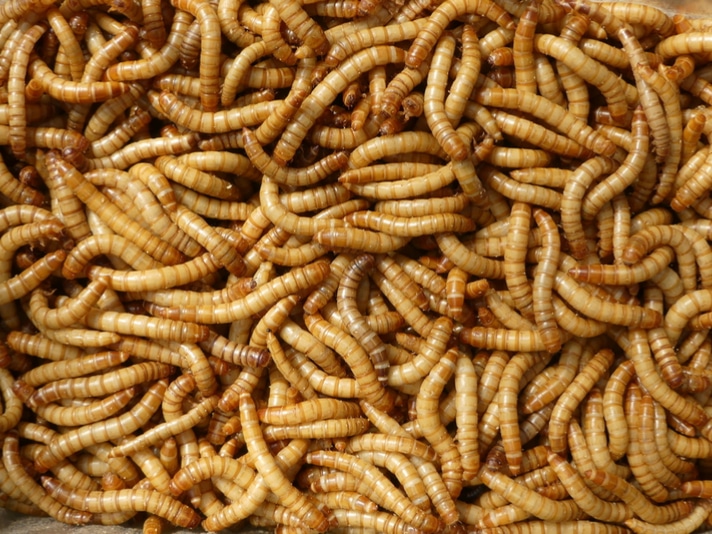
Dusted and gut loaded mealworms are one feeder for your geckos. Photo by IamJang/Shutterstock
The frequency of feeding usually depends on the age of the African fat-tailed gecko. Juveniles can be fed daily, and adults can be fed every two to three days. Very large African fat-tailed geckos can be fed every five days or so. They will usually eat until they aren’t hungry anymore, which usually lasts about 15 minutes and then they will stop. This will depend entirely on the individual animal.
Water
Clean water should be provided daily, along with clean dishes. These should be shallow enough for the geckos to access easily. If water dishes tip over, this can create over-saturated conditions that can lead to microorganisms in the habitat, like bacteria and fungus.
Handling
African fat-tailed geckos are very tolerant of handling, but juveniles may be more scared than adults. Like other geckos, the African fat tails can bite, and will bite, for a variety of reasons. If they are sick, scared, aggressive, or other reasons, they can bite each other or humans quite hard. A keeper who monitors their animals’ behavior, will most likely come to learn what is the norm or when something is not right. Sometimes, they are just “not in the mood.” Identifying animal behavior is an important aspect to exotics. Overall though, AFTs are very tolerant of handling, and they usually remain calm. This is probably a main reason for their rising popularity in the reptile hobby.
Health
Like most reptiles, African fat-tailed geckos can face a variety of health issues due to improper care or other reasons. An exotic vet is necessary for routine check ups or to determine if anything is out of the ordinary. Geckos who are lethargic, stop eating, or behave strangely may be sick.
Conclusion
There is still lots to be learned about African fat-tailed geckos, but so much has been understood through the successful captive management of the species. Many keepers enjoy their “smiling” faces, beautiful colors, and tolerant demeanors. Through sharing knowledge, keepers can learn to achieve the highest quality standards for African fat-tailed geckos and expand the database on their knowledge. Since little is known about their wild lifestyles and behaviors, captivity has provided most information on this species just through the hobby of keeping and breeding.
Even when researching the species and looking for footage of them in the wild, most videos that come up are from Youtubers who personally keep or breed them. African fat-tailed geckos and their story are just another example of the benefits of captivity, especially for reptiles. By working together to continue the success of captive African fat-tailed geckos, they can live a long, meaningful life in captivity that is rewarding for all.
Rebekah Pettit is a middle school science teacher and a trained zoologist based in Florida.

